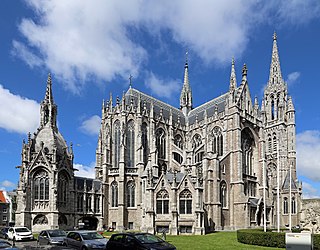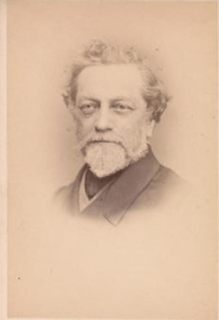
Augustus Welby Northmore Pugin was an English architect, designer, artist and critic with French and, ultimately, Swiss origins. He is principally remembered for his pioneering role in the Gothic Revival style of architecture. His work culminated in designing the interior of the Palace of Westminster in Westminster, London, England, and its iconic clock tower, later renamed the Elizabeth Tower, which houses the bell known as Big Ben. Pugin designed many churches in England, and some in Ireland and Australia. He was the son of Auguste Pugin, and the father of Edward Welby Pugin and Peter Paul Pugin, who continued his architectural firm as Pugin & Pugin. He also created Alton Castle in Alton, Staffordshire.

The Royal Mile is a succession of streets forming the main thoroughfare of the Old Town of the city of Edinburgh in Scotland. The term was first used descriptively in W. M. Gilbert's Edinburgh in the Nineteenth Century (1901), describing the city "with its Castle and Palace and the royal mile between", and was further popularised as the title of a guidebook by R. T. Skinner published in 1920, "The Royal Mile (Edinburgh) Castle to Holyrood(house)".

Portland Stone or Portland Stone Formation is a limestone formation from the Tithonian stage of the Jurassic period quarried on the Isle of Portland, Dorset, England. The quarries are cut in beds of white-grey limestone separated by chert beds. It has been used extensively as a building stone throughout the British Isles, notably in major public buildings in London such as St Paul's Cathedral and Buckingham Palace. Portland Stone is also exported to many countries—being used for example in the United Nations headquarters building in New York City.

Gothic Revival is an architectural movement that began in the late 1740s in England. The movement gained momentum and expanded in the first half of the 19th century, as increasingly serious and learned admirers of the neo-Gothic styles sought to revive medieval Gothic architecture, intending to complement or even supersede the neoclassical styles prevalent at the time. Gothic Revival draws upon features of medieval examples, including decorative patterns, finials, lancet windows, and hood moulds. By the middle of the 19th century, Gothic had become the preeminent architectural style in the Western world, only to fall out of fashion in the 1880s and early 1890s.

County Hall is a building in the district of Lambeth, London that was the headquarters of London County Council (LCC) and later the Greater London Council (GLC). The building is on the South Bank of the River Thames, with Westminster Bridge being next to it, to the south. It faces west toward the City of Westminster and is close to the Palace of Westminster. The nearest London Underground stations are Waterloo and Westminster. It is a Grade II* listed building.

A fan vault is a form of vault used in the Gothic style, in which the ribs are all of the same curve and spaced equidistantly, in a manner resembling a fan. The initiation and propagation of this design element is strongly associated with England.
Henry Yevele was the most prolific and successful master mason active in late medieval England. The first document relating to him is dated 3 December 1353, when he purchased the freedom of London. In February 1356 he was sufficiently well known as a mason that he was chosen as one of a commission of six cutting masons who were to inform the mayor and aldermen about the acts and articles of the craft.

Victoria is an area of Central London in the City of Westminster. It is named after Victoria Station, which is a major transport hub. The station was named after the nearby Victoria Street.

The Old Town is the name popularly given to the oldest part of Scotland's capital city of Edinburgh. The area has preserved much of its medieval street plan and many Reformation-era buildings. Together with the 18th/19th-century New Town, and West End, it forms part of a protected UNESCO World Heritage Site.

London's architectural heritage involves many architectural styles from different historical periods. London's architectural eclecticism stems from its long history, continual redevelopment, destruction by the Great Fire of London and The Blitz, and state recognition of private property rights which have limited large scale state planning. This sets London apart from other European capitals such as Paris and Rome which are more architecturally homogeneous. London's architecture ranges from the Romanesque central keep of The Tower of London, the great Gothic church of Westminster Abbey, the Palladian royal residence Queen's House, Christopher Wren's Baroque masterpiece St Paul's Cathedral, the High Victorian Gothic of The Palace of Westminster, the industrial Art Deco of Battersea Power Station, the post-war Modernism of The Barbican Estate and the Postmodern skyscraper 30 St Mary Axe 'The Gherkin'.

An unfinished building is a building where construction work was abandoned or on-hold at some stage or only exists as a design. It may also refer to buildings that are currently being built, particularly those that have been delayed or at which construction work progresses extremely slowly.

William Frederick Woodington was a notable English painter and sculptor.

The funeral of Diana, Princess of Wales, started on Saturday 6 September 1997 at 9:08 am in London, when the tenor bell of Westminster Abbey started tolling to signal the departure of the cortège from Kensington Palace. The coffin was carried from the palace on a gun carriage by riders of the King's Troop and escorted by mounted police along Hyde Park to St James's Palace, where Diana's body had remained for five days before being taken to Kensington Palace. The Union Flag on top of the palace was lowered to half mast. The official ceremony was held at Westminster Abbey in London and finished at the resting place in Althorp.
The following is a timeline of the history of London, the capital of England and the United Kingdom.

Manhattan Loft Gardens is a 42-storey 143 m (469 ft)-tall apartment building in Stratford, London. The architects and structural engineers are Skidmore, Owings & Merrill.

Operation London Bridge was the funeral plan for Queen Elizabeth II. The plan included the announcement of her death, the period of official mourning, and the details of her state funeral. The plan was created as early as the 1960s and revised many times in the years before her death in 2022.

Perpendicular Gothic architecture was the third and final style of English Gothic architecture developed in the Kingdom of England during the Late Middle Ages, typified by large windows, four-centred arches, straight vertical and horizontal lines in the tracery, and regular arch-topped rectangular panelling. Perpendicular was the prevailing style of Late Gothic architecture in England from the 14th century to the 17th century. Perpendicular was unique to the country: no equivalent arose in Continental Europe or elsewhere in the British Isles. Of all the Gothic architectural styles, Perpendicular was the first to experience a second wave of popularity from the 18th century on in Gothic Revival architecture.
















